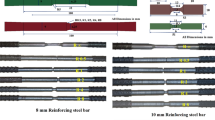Abstract
Broken Charpy specimens can be used in various ways to determine the reference temperature, T 0, as defined in the Master Curve approach. Reconstitution and machining of subsize specimens are two solutions for direct toughness evaluation. The optimum technique and specimen geometry preferentially: use a minimum number of broken half Charpy’s, have a small uncertainty on the reference temperature, have the widest valid test temperature window, have a reasonable cost, and are easy to perform into hot cells. In this study, the use of various miniature specimen types such as Compact (C(T)), Single Edge notch Bend, (SE(B)), or Miniature Precracked Charpy (MPCCv), and Circumferentially Cracked Round Bars (CRB), is investigated. As this study deals with small specimens, the problem of loss of constraint is also addressed. Taking all constraints into account, a 0.16T−C(T) specimen is found to be the more promising geometry. This work is supported by experimental data generated on various specimen types and sizes on the well-characterised reactor pressure vessel steels 22NiMoCr37, 20MoNiCr55 and JRQ.
Similar content being viewed by others
References
Heerens, J. and Hellmann D. (2002). Development of the euro fracture toughness dataset. Engineering Fracture Mechanics 69, 421–449.
Heerens, J., Read, D. T., Cornec, A. and Schwalbe, K.-H. (1991). Interpretation of fracture toughness on the ductile-to-brittle transition region by fractographical observations. Mechanical Engineering Publications, 659–678.
Lucon, E., Scibetta, M. and van Walle E. (2001). Assessment of the Master Curve Approach on Three Reactor Pressure Vessel Steels (JRQ, JSPS, 22NiMoCr37). IAEA Specialists’ Meeting on Master Curve Testing and Results Application, 17–19 September 2001, Prague, Czech Republic
Lucon, E., Scibetta, M., Chaoudi, R. and van Walle E. (2002). Fracture Toughness Measurements in the Transition Region Using Sub-Size Precracked Charpy and Cylindrical Bar Specimens. Small Specimen Test Techniques: Fourth Volume, ASTM STP 1418, M. A. Sokolov, J. D. Landes, and G. E. Lucas, Eds., American society for Testing and Materials, West Conshohocken, PA.
Scibetta, M. and Chaouadi, R. (1997). Effect of reconstitution on fracture toughness measured with PCCv. report BLG-749, SCK·CEN Mol, Belgium.
Scibetta, M. (1999). Contribution to the Evaluation of the Circumferentially-Cracked Round Bar for Fracture Toughness Determination of Reactor Pressure Vessel Steels. Doctoral Thesis, University of Liège, Belgium.
Scibetta, M., Chaouadi, R. and van Walle, E. (2000). Fracture toughness analysis of circumferentially-cracked round bars. International Journal of Fracture 104, 145–168.
Scibetta, M. (2000). Constraint Assessment in PCCv and 1T C(T) Specimens using 3-D Finite Element Simulations. report BLG-861, SCK·CEN Mol, Belgium.
Scibetta, M., Lucon, E. and van Walle, E. (2001).Technical Appendix of ‘Optimal Use of Broken Charpy Specimens from Surveillance Programs for the Application of the Master Curve Approach’. report BLG-888, SCK·CEN Mol, Belgium.
van Walle, E. (1997). Belgian Contribution to the IAEA CRP-IV Programme on ‘Assuring Structural Integrity of Reactor Pressure Vessel Steels’. report BLG-754, SCK·CEN Mol, Belgium.
van Walle, E. et al. (2000). RESQUE: Reconstitution Techniques Qualification & Evaluation to study Ageing Phenomena of Nuclear Pressure Vessel Materials Final Report: Recommendations for Reconstitution of Non-Irradiated and Irradiated Charpy-size Specimens, report R-3450, SCK·CEN Mol, Belgium.
Wallin, K. (1998). Master curve analysis of ductile to brittle transition region fracture toughness round robin data. The ‘EURO’fracture toughness curve. VTT Publications: 367, Espoo, 1–58.
Author information
Authors and Affiliations
Rights and permissions
About this article
Cite this article
Scibetta, M., Lucon, E. & van Walle, E. Optimum use of broken Charpy specimens from surveillance programs for the application of the master curve approach. International Journal of Fracture 116, 231–244 (2002). https://doi.org/10.1023/A:1020165900918
Issue Date:
DOI: https://doi.org/10.1023/A:1020165900918




